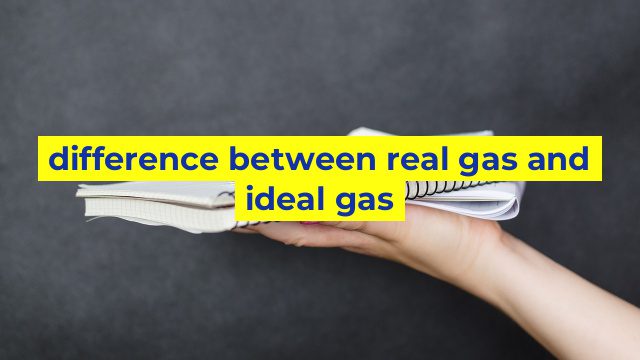Difference Between Real Gas and Ideal Gas
Introduction
Gases are often studied in physics and chemistry, and they can be classified as either ideal or real. While both types of gases have similar properties, there are distinct differences between the two that scientists and engineers need to know to accurately measure and predict gas behavior.
Ideal Gas
An ideal gas is a theoretical gas that is made up of particles that have no volume and do not attract or repel each other. According to this theory, the particles in an ideal gas are infinitely small, lightweight, and do not have any intermolecular forces. This means that an ideal gas will always follow the ideal gas law, which describes the relationship between the pressure, volume, and temperature of a gas.
Because it is a theoretical concept, ideal gases do not exist in the real world. However, scientists often use ideal gases as a model to analyze and predict the behavior of real gases. Ideal gases are useful for predicting the behavior of gases in high-pressure and high-temperature conditions, such as those found in combustion engines.
Real Gas
A real gas is any gas that deviates from the behavior predicted by the ideal gas law. The behavior of a real gas is affected by factors such as intermolecular forces, particle size, and pressure. Real gases have volume and intermolecular forces that cause them to behave differently from ideal gases.
The properties of a real gas depend on its temperature, pressure, and volume. At high pressures and low temperatures, real gases behave more like liquids. At low pressures and high temperatures, real gases behave more like ideal gases. This is because the kinetic energy of the gas particles increases with temperature, which allows them to overcome intermolecular forces and behave more like an ideal gas.
Differences
The main difference between real and ideal gases is that real gases have intermolecular forces and non-zero volume, while ideal gases do not. As a result, ideal gases follow the ideal gas law, which is a simplified version of the behavior of real gases. Real gases deviate from this law due to the factors mentioned above.
Another difference between real and ideal gases is their behavior at high pressures and low temperatures. Real gases tend to condense into a liquid state, while ideal gases remain in the gas state. This difference is due to the intermolecular forces that affect real gases but do not exist in ideal gases.
Conclusion
Ideal and real gases are both important concepts in physics and chemistry. While the behavior of ideal gases is easy to predict, it is not always accurate in the real world. Real gases can deviate from the ideal gas law due to intermolecular forces, particle size, and pressure. Understanding the differences between real and ideal gases is essential for accurately predicting the behavior of gases in various conditions.
Table difference between real gas and ideal gas
| Property | Ideal Gas | Real Gas |
|---|---|---|
| Molecules | Assumes all gas molecules have zero volume and no interactions between them | Accounts for molecular size and intermolecular interactions |
| Pressure | Increased pressure results in decreased volume | At high pressures, molecules are closer together and take up space, leading to a decrease in volume |
| Temperature | Increasing temperature increases pressure and volume | Molecules have more kinetic energy and can overcome intermolecular interactions resulting in increased volume and pressure is affected by molecular attraction/repulsion |
| Behavior at Low Temperatures and High Pressures | Ideal gas laws break down and cannot predict behavior accurately | Intermolecular interactions and molecular size become significant and cannot be ignored |
